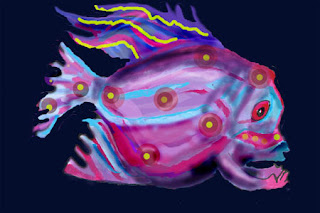2016-05-31
Landscape in Red
This time I tried painting in wet-and-wet technique. I used my colorex watercolour inks and two brushes - one for wetting the paper with clear water and smoothing out the paint and the other one for applying the paint. When the paint had dried I took one of my alcohol-based markers and added the frame and some parts of the silhouettes.
2016-05-29
My Inks
Here you can see some of the art materials I am using: on the left is a stack of lids left over from my yoghurts. They are plastic and I use them as palettes for my acrylic paints - the inks as well as the tube paints. When too much dried paint covers the lid I simply put them into the bin. Eating yogurt is good for your bones - so with every yoghutt I eat I do something for my health and for my art activites!
Then there are my inks - first the colorex inks which I bought as a starter set together with one bottle of ecoline, and then my acrylic inks from Schmincke. These inks are mostly used for airbrushing but you can also use them with a brush.
2016-05-28
Digital fish
Here I took one of my colorex paintings and transformed it into a digital painting. I used photoshop 7, quite an old version of photoshop but nevertheless one which does everything I want it to do.
The big advantage when painting digital is that you can really play with colours and shapes. You can work on it up the point when you are satisfied with it, erasing lines, going over it with another colour and another brush.
2016-05-23
Red
With this painting I switched again from digital to analogue - or in other words - to tradtional art. I used acrylic paints and acrylic inks here, trying to mix various shades of red.
2016-05-17
Colouring in the digital way
After having kind of digitalized some traditional artwork of mine I felt like doing a colouring page the digital way. It's a very fun way of playing around with colour combinations!
2016-05-15
Ring of Stones - Digital
It has been a long time ago since I did a digital painting. However, I have subscribed to a lot of channels which do digital art, and just a few days ago I actually watched one of these videos. I not only watched more than one but also felt the urge to do something digital myself.
As I didn't want to begin from scratch I had a look at one of my scanned paintings and thought "why not try to enhance that painting digitalloy?" And I did. Doing this I learnt two things:
- Digital art takes at least the same time as traditional art - if not even more. It is important to give onself time to experiment and play.
- Look for your lightest lights and your darkest darks - something that is important for traditional art - but also for digital art. And the advantage of a digital painting is that you can darken your paintings without having to fear to darken them too much - if that is the case just go over the spots again.
2016-05-01
Dancing Sea Snakes
Isn't it amazing how many shades of blue exist? And how many can be created by either adding white to blue, or black to blue, or thinning the paint with water, or put a thin layer of blue ink over the painting?
The only thing is: Be careful when shaking the bottle of ink - make sure that the lid is tight... Otherwise you'll get the same result as you get when changing the ink cartridges on your inkjet printer - paint or ink all over your fingers. And: Whereas I found acrylic paint can removed quite easily from your hands by giving them a scrubbing up with your soap, it is far more difficult to remove acrylic ink. I still got some under my nails...
Subscribe to:
Posts (Atom)






